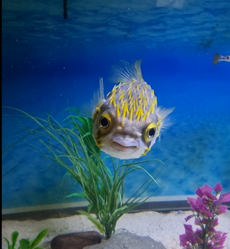
Here at the Marine Discovery Centre, we’re lucky to host a number of aquatic animals from our freshwater rivers as well as from the wilds of the Great Southern Reef (like Porci, our favourite little mascot!)

Porci ready for a snack! Image credit: Alesha Brewer
But making sure these guys have a safe and clean environment to live in isn’t as simple as just dumping some water in a tank. Just like how we need the right composition of chemicals in the air to breathe and keep our lungs healthy, aquatic animals need just the right chemicals in the water to thrive. They need the correct pH and the right amount of salinity, but we especially need to keep an extra close eye on three specific chemicals – ammonia, nitrite, and nitrate – which make up the nitrogen cycle.
So what is the Nitrogen Cycle?
Put simply, it’s the way in which organic waste (such as uneaten food, debris from plants, or animal excretions) breaks down into compounds of nitrogen. Different strains of helpful bacteria in our tanks break this waste from one form to another in 3 main steps.
First, waste is broken down into ammonia (NH3). We can’t tell it’s there as it’s colourless, but our little critters can, as ammonia can be toxic in large doses. It can inhibit growth and development as well as cause damage to the central nervous system. This is especially true especially at higher pH levels, where a higher concentration of unionised ammonia is present which is much more easily able to penetrate through membranes and cause damage to living tissue.
Luckily, we’ve got a second strain of bacteria up our sleeve! This time, the ammonia is turned into nitrite (NO2-). Unluckily, nitrite is even more toxic than ammonia. Even small amounts can damage how well aquatic creatures can move oxygen through their blood. In order to keep our animals safe, we’ve got to rely on one last type of bacteria.
In the final step of the nitrogen cycle, the toxic nitrites are turned into nitrates (NO-3). While still not great to have in the tank, nitrates are far less toxic and really only become harmful at very high concentrations. That’s why it’s important for all aquariums to have the right balance of bacteria that can turn waste into nitrates quickly and avoid creating harmful concentrations of ammonia or nitrite.
We can get rid of nitrates by regularly changing the water in our tanks. Replacing just a few buckets a week does the trick and is an important part of our tank maintenance routines. We also make sure to monitor the levels of nitrogen compounds by testing water samples with chemical indicators, which warn us if something is going wrong.

Just a few of the chemical tests we use regularly to keep our tanks healthy. Image Credit: API
While it’s great that we can rely on our helpful bacteria to help us control waste in our tanks, it introduces some aquatic chemistry that all responsible aquarium keepers should be familiar with. If you’ve got your own aquatic animals at home, or if you’re just thinking about setting up your own tanks, it’s important to be familiar with the science of the environment you’re replicating – to keep your new friends happy and healthy!
Article by Alesha Brewer
References
Australian and New Zealand Guidelines for Fresh & Marine Water Quality (2000) Ammonia in water and marine water. Available at: https://www.waterquality.gov.au/anz-guidelines/guideline-values/default/water-quality-toxicants/toxicants/ammonia-2000
Camargo, J.A. and Alonso, Á. (2006) ‘Ecological and toxicological effects of inorganic nitrogen pollution in Aquatic Ecosystems: A global assessment’, Environment International, 32(6), pp. 831–849. doi:10.1016/j.envint.2006.05.002.
Randall, D.J. and Tsui, T.K.N. (2002) ‘Ammonia toxicity in fish’, Marine Pollution Bulletin, 45(1–12), pp. 17–23. doi:10.1016/s0025-326x(02)00227-8.